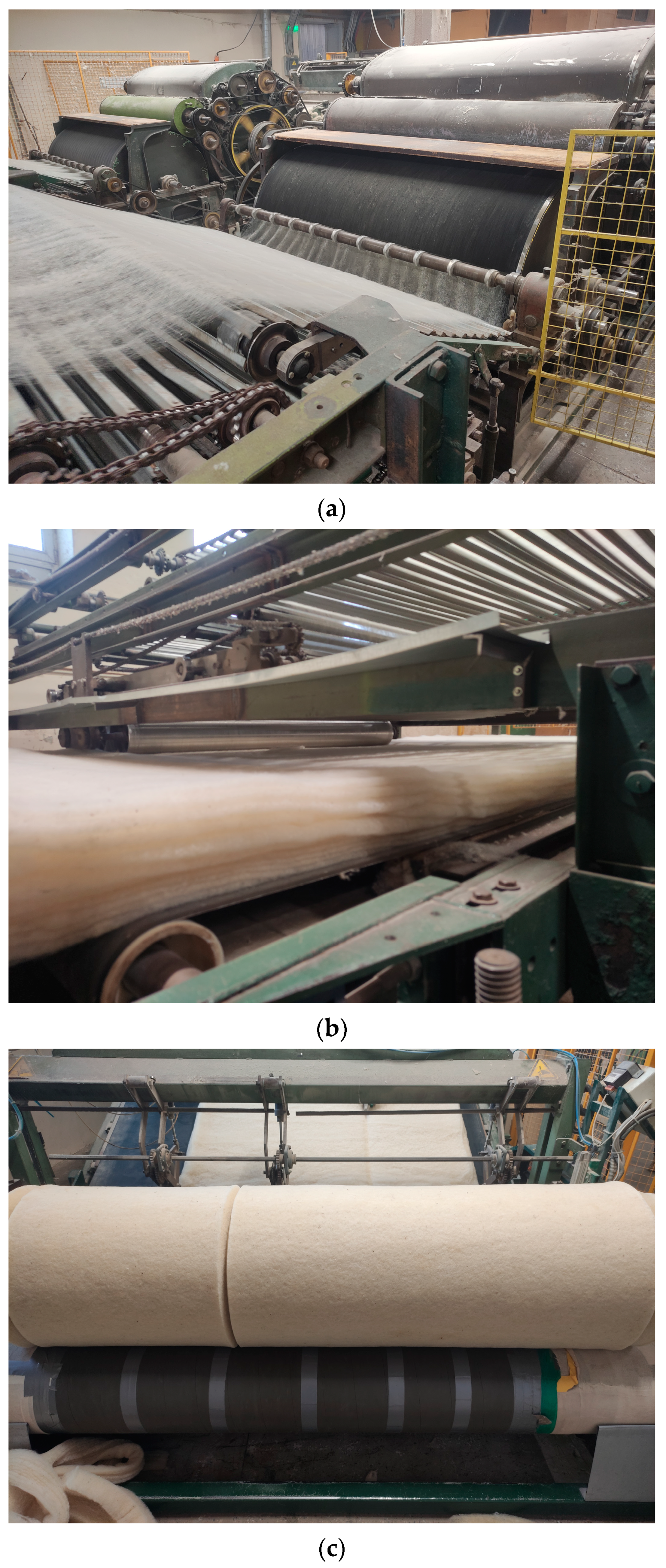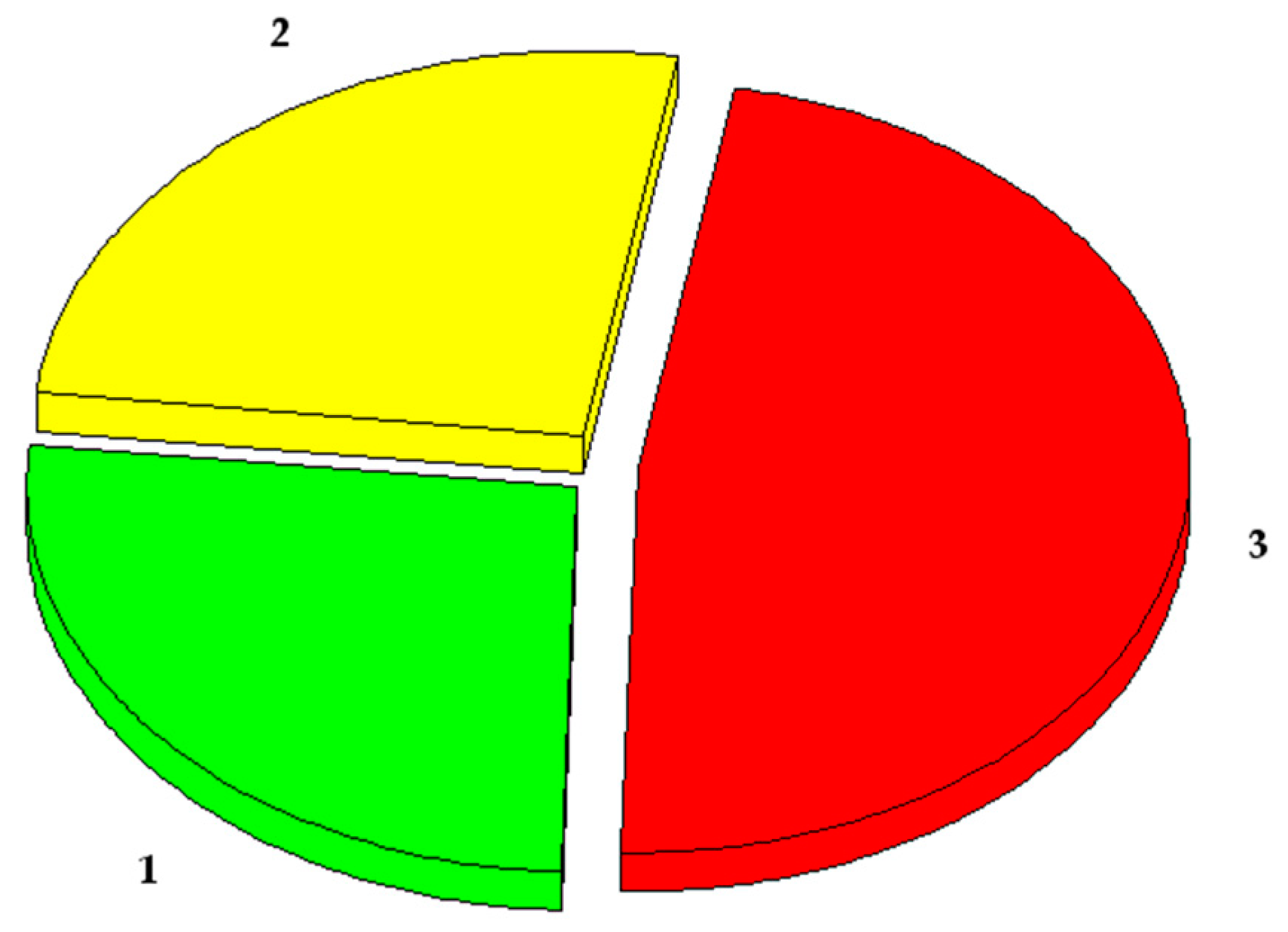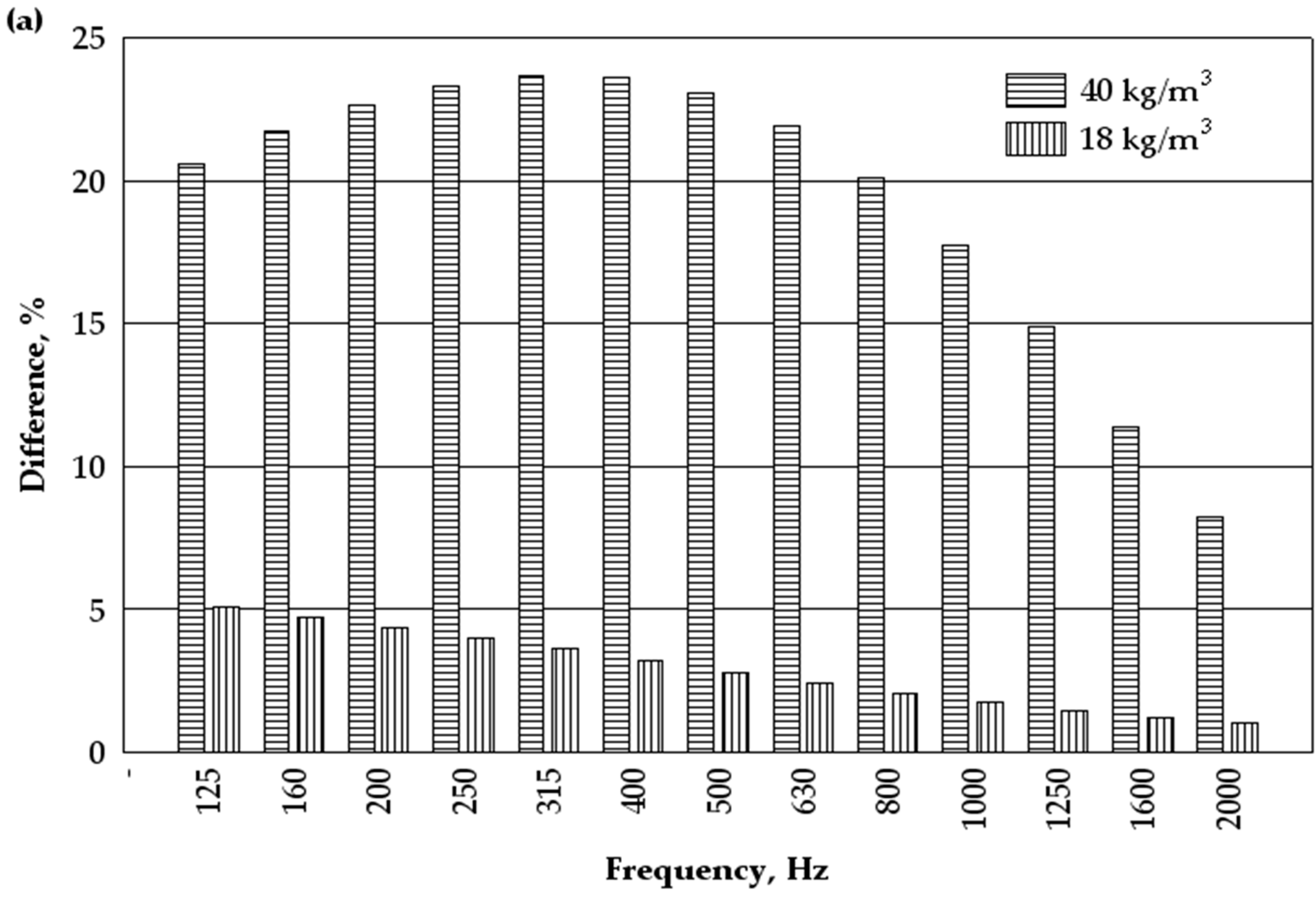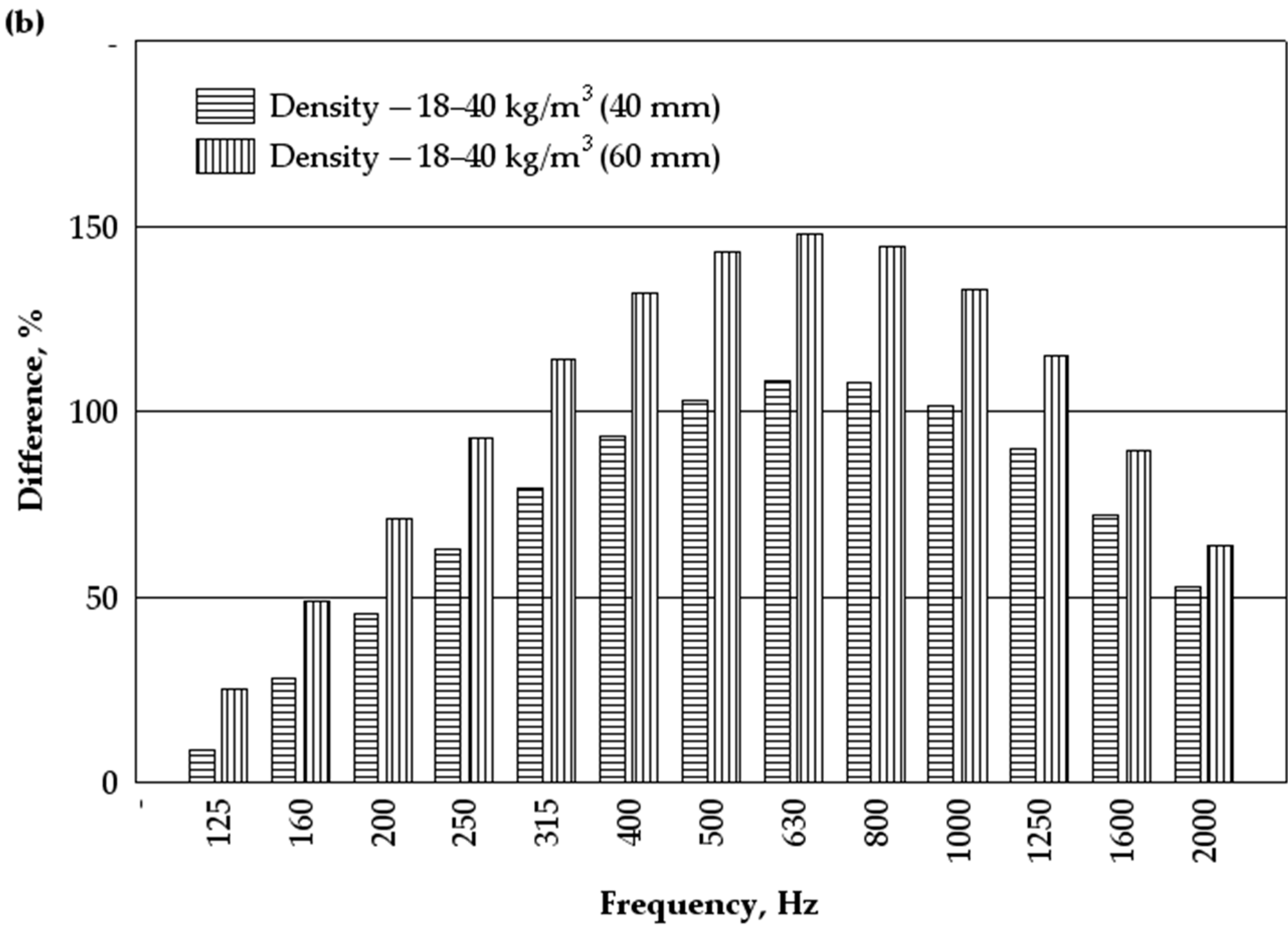Reuse of Textile Waste in the Production of Sound Absorption Boards
Abstract
1. Introduction
2. Materials and Methods
2.1. Raw Materials
2.2. Determination of Woollen Yarn Waste Composition
2.3. Production of Soft Boards
2.4. Determination of the Sound Absorption Coefficient
2.5. Methods of Processing the Experimental Data
3. Results and Discussion
3.1. Analysis of Woollen Yarn Waste
3.2. Production of Soft Fibrous Boards
3.3. Acoustical Characteristics
4. Conclusions
Author Contributions
Funding
Institutional Review Board Statement
Informed Consent Statement
Data Availability Statement
Conflicts of Interest
References
- Yu, X.; Fan, W.; Azwar, E.; Ge, S.; Xia, C.; Sun, Y.; Gao, X.; Yang, X.; Wang, S.; Lam, S.S. Twisting in improving processing of waste-derived yarn into high-performance reinforced composite. J. Clean. Prod. 2021, 317, 128446. [Google Scholar] [CrossRef]
- Horvat, K.P.; Wendramin, K.Š. Issues Surrounding Behavior toward Discarded Textiles and Garments in Ljubljana. Sustainability 2021, 13, 6491. [Google Scholar] [CrossRef]
- DeVoy, J.E.; Congiusta, E.; Lundberg, D.J.; Findeisen, S.; Bhattacharya, S. Post-Consumer textile waste and disposal: Differences by socioeconomic, demographic, and retail factors. Waste Manag. 2021, 136, 303–309. [Google Scholar] [CrossRef] [PubMed]
- Li, X.; Wang, L.; Ding, X. Textile supply chain waste management in China. J. Clean. Prod. 2021, 289, 125147. [Google Scholar] [CrossRef]
- U.S. EPA. Textiles: Material-Specific Data. 2018. Available online: https://www.epa.gov/facts-and-figures-about-materials-waste-and-recycling/textiles-material-specific-data (accessed on 14 January 2022).
- Jäämaa, L.; Kaipia, R. The first mile problem in the circular economy supply chains—Collecting recyclable textiles from consumers. Waste Manag. 2022, 141, 173–182. [Google Scholar] [CrossRef] [PubMed]
- Guo, H.N.; Wu, S.B.; Tian, Y.J.; Zhang, J.; Liu, H.T. Application of machine learning methods for the prediction of organic solid waste treatment and recycling processes: A review. Bioresour. Technol. 2021, 319, 124114. [Google Scholar] [CrossRef]
- Tedesco, S.; Montacchini, E. From Textile Waste to Resource: A Methodological Approach of Research and Experimentation. Sustainability 2020, 12, 10667. [Google Scholar] [CrossRef]
- Alkazam. Automated Sorting Technology from T4T Can Help Improve Recovery and Efficiency. J. Textile Sci. Eng. 2013, 3, 1000136. [Google Scholar] [CrossRef]
- Carlsson, J.; Torstensson, H.; Pal, R.; Paras, M.K. Planning a Swedish Collection and Sorting Plant for Used Textiles. Technical Report. 2015. Available online: https://smarttextiles.se/wp-content/uploads/2020/07/Planning-a-Swedish-Collection-and-Sorting-Plant-for-Used-Textiles.pdf (accessed on 14 January 2022).
- Cura, K.; Rintala, N.; Kamppuri, T.; Saarimäki, E.; Heikkilä, P. Textile Recognition and Sorting for Recycling at an Automated Line Using Near Infrared Spectroscopy. Recycling 2021, 6, 11. [Google Scholar] [CrossRef]
- Du, W.; Zheng, J.; Li, W.; Liu, Z.; Wang, H.; Han, X. Efficient Recognition and Automatic Sorting Technology of Waste Textiles Based on Online Near Infrared Spectroscopy and Convolutional Neural Network. Resour. Conserv Recycl. 2022, 180, 106157. [Google Scholar] [CrossRef]
- Ferdous, W.; Manalo, A.; Siddique, R.; Mendis, P.; Zhuge, Y.; Wong, H.S.; Lokuge, W.; Aravinthan, T.; Schubel, P. Recycling of landfill wastes (tyres, plastics and glass) in construction—A review on global waste generation, performance, application and future opportunities. Resour. Conserv. Recycl. 2021, 173, 105745. [Google Scholar] [CrossRef]
- Abd, S.M.; Mhaimeed, I.S.; Tayeh, B.A.; Najm, H.M.; Qaidi, S. Investigation of the use of textile carbon yarns as sustainable shear reinforcement in concrete beams. Case Stud. Constr. Mater. 2023, 18, e01765. [Google Scholar] [CrossRef]
- Grings, K.J.O.; Carneiro Ribeiro, F.R.; Junior, D.V.A.; de Azevedo, A.R.G.; Kulakowski, M.P. Evaluation of Light Cementitious Matrix with Composite Textile Reinforcement from Garment Waste. Materials 2023, 16, 733. [Google Scholar] [CrossRef] [PubMed]
- Sadrolodabaee, P.; Claramunt, J.; Ardanuy, M.; de la Fuente, A. Mechanical and durability characterization of a new textile waste micro-fiber reinforced cement composite for building applications. Case Stud. Constr. Mater. 2021, 14, e00492. [Google Scholar] [CrossRef]
- Ghermezgoli, Z.M.; Moezzi, M.; Yekrang, J.; Rafat, S.A.; Soltani, P.; Barez, F. Sound absorption and thermal insulation characteristics of fabrics made of pure and crossbred sheep waste wool. J. Build Eng. 2021, 35, 102060. [Google Scholar] [CrossRef]
- Dissanayake, D.G.K.; Weerasinghe, D.U.; Thebuwanage, L.M.; Bandara, U.A.A.N. An environmentally friendly sound insulation material from post-industrial textile waste and natural rubber. J. Build. Eng. 2021, 33, 101606. [Google Scholar] [CrossRef]
- Patnaik, A.; Mvubu, M.; Muniyasamy, S.; Botha, A.; Anandjiwala, R.D. Thermal and sound insulation materials from waste wool and recycled polyester fibers and their biodegradation studies. Energy Build. 2015, 92, 161–169. [Google Scholar] [CrossRef]
- Massoudinejud, M.; Amanidaz, N.; Santos, R.M.; Bakhshoodeh, R. Use of municipal, agricultural, industrial, construction and demolition waste in thermal and sound building insulation materials: A review article. J. Environ. Health Sci. Eng. 2019, 17, 1227–1242. [Google Scholar] [CrossRef]
- Wiprächtiger, M.; Haupt, M.; Heeren, N.; Waser, E.; Hellweg, S. A framework for sustainable and circular system design: Development and application on thermal insulation materials. Resour. Conserv. Recycl. 2020, 154, 104631. [Google Scholar] [CrossRef]
- Elella, M.H.A.; Goda, E.S.; Yoon, K.R.; Hong, S.E.; Morsy, M.S.; Sadak, R.A.; Gamal, H. Novel vapor polymerization for integrating flame retardant textile with multifunctional properties. Compos. Commun. 2021, 24, 100614. [Google Scholar] [CrossRef]
- Qian, L.J.; Ye, L.J.; Xu, G.Z.; Liu, J.; Guo, J.Q. The non-halogen flame retardant epoxy resin based on a novel compound with phosphaphenanthrene and cyclotriphosphazene double functional groups. Polym. Degrad. Stab. 2011, 96, 1118–1124. [Google Scholar] [CrossRef]
- Knutsen, H.; Arp, H.P.H. Preventing brominated flame retardants from occurring in recycled expanded polystyrene: Comparing Norwegian visual sorting with advanced screening methods. J. Hazard. Mater. Lett. 2021, 2, 100016. [Google Scholar] [CrossRef]
- Schlummer, M.; Maurer, A.; Wagner, S.; Berrang, A.; Fell, T.; Knappich, F. Recycling of Flame Retarded Waste Polystyrene Foams (EPS and XPS) to PS Granules Free of Hexabromocyclododecane (HBCDD). Adv. Recycl. Waste. Manag. 2017, 2, 1000131. [Google Scholar] [CrossRef]
- EN ISO 1833-1; Textiles—Quantitative Chemical Analysis—Part 1: General Principles of Testing. International Organization for Standardization: Geneva, Switzerland, 2020.
- ISO 1833-4; Textiles—Quantitative Chemical Analysis—Part 4: Mixtures of Certain Protein Fibres with Certain other Fibres (Method Using Hypochlorite). International Organization for Standardization: Geneva, Switzerland, 2017.
- ISO 1833-7; Textiles—Quantitative Chemical Analysis—Part 7: Mixtures of Polyamide with Certain Other Fibres (Method using Formic acid). International Organization for Standardization: Geneva, Switzerland, 2017.
- ISO 1833-11; Textiles—Quantitative Chemical Analysis—Part 11: Mixtures of Certain Cellulose Fibres with Certain Other Fibres (Method Using Sulfuric Acid). International Organization for Standardization: Vernier, Geneva, Switzerland, 2017.
- ISO 10534-1; Acoustics—Determination of Sound Absorption Coefficient and Impedance in Impedance Tubes—Part 1: Method Using Standing Wave Ratio. International Organization for Standardization: Geneva, Switzerland, 1996.
- Data Science Textbook. 2020. Available online: https://docs.tibco.com/data-science/textbook (accessed on 15 September 2022).
- Chatterjee, S.; Simonoff, S.J. Handbook of Regression Analysis, 1st ed.; John Wiley & Sons Inc.: Hoboken, NJ, USA, 2013; pp. 3–22. [Google Scholar]
- Stapulionienė, R.; Vaitkus, S.; Vėjelis, S.; Sankauskaitė, A. Investigation of thermal conductivity of natural fibres processed by different mechanical methods. Int. J. Precis. Eng. Manuf. 2016, 17, 1371–1381. [Google Scholar] [CrossRef]
- Berardi, U.; Iannace, G. Acoustic characterization of natural fibers for sound absorption applications. Build. Environ. 2015, 94, 840–852. [Google Scholar] [CrossRef]
- Zach, J.; Korjenic, A.; Petranek, V.; Hroudova, J.; Bednar, T. Performance evaluation and research of alternative thermal insulations based on sheep wool. Energ. Build. 2012, 49, 246–253. [Google Scholar] [CrossRef]
- Ballagh, K.O. Acoustical properties of wool. Appl. Acoust. 1996, 48, 101–120. [Google Scholar] [CrossRef]
- Oldham, D.J.; Egan, C.A.; Cookson, R.D. Sustainable acoustic absorbers from the biomass. Appl. Acoust. 2011, 72, 350–363. [Google Scholar] [CrossRef]
- Moretti, E.; Belloni, E.; Agosti, F. Innovative mineral fiber insulation panels for buildings: Thermal and acoustic characterization. Appl. Energ. 2016, 169, 421–432. [Google Scholar] [CrossRef]
- Buratti, C.; Moretti, E.; Belloni, E.; Agosti, F. Thermal and Acoustic Performance Evaluation of New Basalt Fiber Insulation Panels for Buildings. Energ. Procedia 2015, 78, 303–308. [Google Scholar] [CrossRef]
- Iannace, G. The acoustic characterization of green materials. Build. Acoust. 2017, 24, 1–13. [Google Scholar] [CrossRef]
- Xiang, H.F.; Wang, D.; Liu, H.; Zhao, N. Investigation on sound absorption properties of kapok fibers. Chin. J. Polym. Sci. 2013, 31, 521–529. [Google Scholar] [CrossRef]
- Roncen, R.; Fellah, Z.E.A.; Piot, E.; Simon, F.; Ogam, E.; Fellah, M.; Depollier, C. Inverse identification of a higher order viscous parameter of rigid porous media in the high frequency domain. J. Acoust. Soc. Am. 2019, 145, 1629–1639. [Google Scholar] [CrossRef] [PubMed]
- Hurrell, A.I.; Horoshenkov, K.V.; Pelegrinis, M.T. The accuracy of some models for the airflow resistivity of nonwoven materials. Appl. Acoust. 2018, 130, 230–237. [Google Scholar] [CrossRef]
- Asdrubali, F.; D’Alessandro, F.; Schiavoni, S. A review of unconventional sustainable building insulation materials. Sustain. Mat. Technol. 2015, 4, 1–17. [Google Scholar] [CrossRef]






| Quantity of Fibrous and Non-Fibrous Matter in Waste, Mass % | ||||
|---|---|---|---|---|
| Wool Fibres | Organic Fibres | Other Fibres | Salts, etc. | Fats |
| 95.0 | 0.6 | 0.5 | 2.8 | 1.1 |
| Test Specimens Indicators | Composition of the Specimens | ||
|---|---|---|---|
| Thickness of the Specimen, mm | Density of the Specimen, kg/m3 | Woollen Waste, mass % | Polylactide, mass % |
| 40 | 18 | 87 | 13 |
| 60 | 18 | ||
| 40 | 40 | ||
| 60 | 40 | ||
| Number of Regression Equations | Number of Tests (Estimations) | Values of Constant Coefficients of Equations (4)–(7) | Sr | |||
|---|---|---|---|---|---|---|
| (4) | 39 | 0.08618 | 0.00024 | 0.9955 | 0.01315 | |
| (5) | 39 | 0.08054 | 0.00024 | 0.9879 | 0.01543 | |
| (6) | 39 | 0.953021 | 0.000971 | 1.022208 | 0.9971 | 0.01396 |
| (7) | 39 | 0.963258 | 0.00087 | 1.084321 | 0.9949 | 0.02022 |
| Materials Density, kg/m3 | Thickness, mm | Frequency of Sound Waves, Hz | NRC | |||
|---|---|---|---|---|---|---|
| 250 | 500 | 1000 | 2000 | |||
| Sound Absorption Coefficient | ||||||
| 18 | 40 | 0.15 | 0.20 | 0.33 | 0.55 | 0.35 |
| 18 | 60 | 0.15 | 0.20 | 0.33 | 0.53 | 0.35 |
| 40 | 40 | 0.22 | 0.40 | 0.65 | 0.84 | 0.55 |
| 40 | 60 | 0.27 | 0.52 | 0.78 | 0.89 | 0.65 |
Disclaimer/Publisher’s Note: The statements, opinions and data contained in all publications are solely those of the individual author(s) and contributor(s) and not of MDPI and/or the editor(s). MDPI and/or the editor(s) disclaim responsibility for any injury to people or property resulting from any ideas, methods, instructions or products referred to in the content. |
© 2023 by the authors. Licensee MDPI, Basel, Switzerland. This article is an open access article distributed under the terms and conditions of the Creative Commons Attribution (CC BY) license (https://creativecommons.org/licenses/by/4.0/).
Share and Cite
Vėjelis, S.; Vaitkus, S.; Kremensas, A.; Kairytė, A.; Šeputytė-Jucikė, J. Reuse of Textile Waste in the Production of Sound Absorption Boards. Materials 2023, 16, 1987. https://doi.org/10.3390/ma16051987
Vėjelis S, Vaitkus S, Kremensas A, Kairytė A, Šeputytė-Jucikė J. Reuse of Textile Waste in the Production of Sound Absorption Boards. Materials. 2023; 16(5):1987. https://doi.org/10.3390/ma16051987
Chicago/Turabian StyleVėjelis, Sigitas, Saulius Vaitkus, Arūnas Kremensas, Agnė Kairytė, and Jurga Šeputytė-Jucikė. 2023. "Reuse of Textile Waste in the Production of Sound Absorption Boards" Materials 16, no. 5: 1987. https://doi.org/10.3390/ma16051987
APA StyleVėjelis, S., Vaitkus, S., Kremensas, A., Kairytė, A., & Šeputytė-Jucikė, J. (2023). Reuse of Textile Waste in the Production of Sound Absorption Boards. Materials, 16(5), 1987. https://doi.org/10.3390/ma16051987







